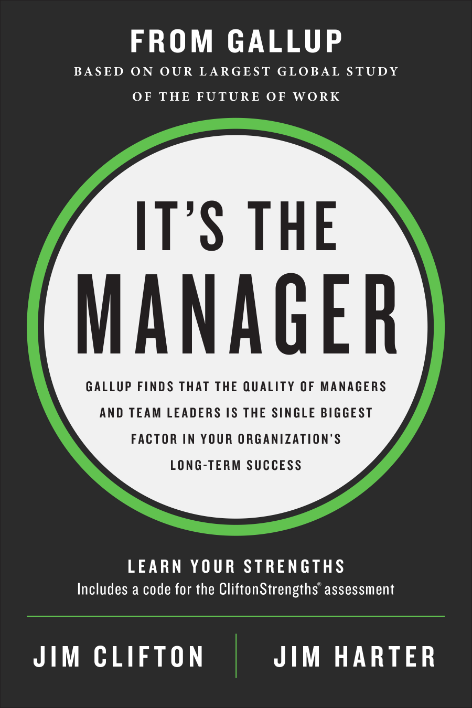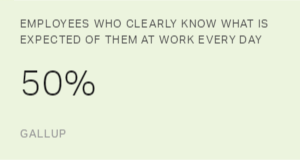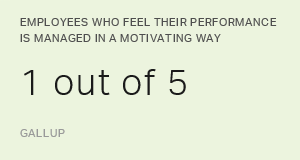It's important for leaders to ask: Do our performance reviews really help us get the most out of our people?
Managers are required, in most organizations, to sit down once a year with each of their team members and have this weird conversation: the annual performance review.
It tends to feel forced and awkward, and it usually doesn't do a lot to help employees get better at their jobs.
According to Gallup, only 14% of employees strongly agree their performance reviews inspire them to improve.
In other words, if performance reviews were a drug, they would not meet FDA approval for efficacy.
For most organizations, the performance review is simply assumed to be "the right thing to do." That's how we're supposed to determine pay and establish accountability, right?
But in recent years, many business leaders have started asking themselves, "Why do we do this in the first place?" Are our performance reviews really helping us get the most out of our people and engage them?
When organizations put their performance management system under a microscope, the answer is a resounding "NO." It does not equip, inspire and improve performance. It is not the best system for determining pay and promotion.
And it costs organizations a lot of money -- as much as $2.4 million to $35 million a year in lost working hours for an organization of 10,000 employees to take part in performance evaluations -- with very little to show for it.
Does that mean organizations should throw out their performance reviews altogether and replace them with something new? And if so, what?
Based on our decades of collective research -- my field work with Stanford University and Gallup's analytics -- here's what we have learned:
1. Performance reviews in most organizations are so bad they do more harm than good.
Traditional performance reviews and approaches to feedback are often so bad that they actually make performance worse about one-third of the time.
The reasons for this are many. First, odds are the manager hasn't been giving employees regular feedback. So, by the time the employee is hearing praise or correction, the issues are history -- they have either been resolved or are in the distant past. The result is that it feels like an unnecessary rehashing of a painful time or praise that comes far too late -- an afterthought.
In fact, nearly half of employees say they receive feedback from their manager a few times a year or less.
Notably, many industries are filled with "accidental managers" -- for example, a department chair in higher education -- where someone only puts on their supervisor hat once a year during a performance review. They haven't been actively managing their subordinate in any meaningful way up until that moment.
In addition, most managers haven't been trained to evaluate performance, give feedback or charter a developmental plan. This can lead to an unnatural conversation in which employees feel like they are talking to a completely different person than they are used to working with.
Another major cause of awkwardness is that most performance reviews are trying to do too many things in a single conversation.
For example, performance reviews are often used for:
- offering advice on how to improve
- setting an employee's bonus or raise
- deciding on a promotion
- justifying a future firing
Unfortunately, legal protections can loom large here. They can add a layer of confusing subtext to the conversation, and it's also one reason traditional performance reviews have persisted so long, though they are so ineffective: Creative reinvention of performance reviews often involves a discussion with the legal department.
Mixing all the above elements effectively into one annual, standardized conversation is complicated -- maybe impossible.
A good starting place for improvement is to separate some of these topics into different conversations. For example, separating the pay conversation and performance review conversation into two separate meetings ensures each topic is given the right focus.
Similarly, organizations might consider using different formal processes and tools when employees are up for a promotion or needing to be put on a performance improvement plan. In this way, a promotion track conversation looks and feels differently than a disciplinary track conversation.
2. Strong evidence about alternatives to performance reviews is lacking, but there are a few important insights that you should consider.
Over the past several years, many well-known companies have experimented with different ways of doing performance evaluations, including eliminating them all together. Some changes have worked, some have not, and for some, it's too early to tell.
These alternatives may be better (or worse) than traditional annual reviews. The jury's still out.
Nevertheless, organizational readiness for change has proven an important factor. When new approaches are confusing, burdensome or counter-cultural, they're met with frustration and resistance.
There also doesn't seem to be a silver bullet for improving performance reviews organization-wide. What works for front-line workers in a manufacturing environment or a call center doesn't necessarily work for computer programmers and senior leaders.
That said, some key changes work better for everyone. Simplifying performance reviews and making them more flexible and relevant to the work being done has been popular with both managers and employees.
Early evidence indicates that teaching managers and employees to have more frequent, meaningful conversations about work expectations, progress and development improves engagement and performance.
However, early evidence also suggests that when organizations replace annual reviews with more frequent or more subjective systems, but don't provide sufficient training, they quickly discover their managers don't know how to talk to employees.
Donna Morris, an HR leader at Adobe, discovered that, in order to effectively lead regular check-ins, managers needed to be trained on how to talk to employees -- literally role-playing what a positive manager-employee check-in looks like.
When it comes to the developmental aspect of a performance review, the real questions employees want answered are, "What do I need to do to be more successful?" and, "What does my future look like?" There's not always a cut-and-dry answer to those questions.
Effective coaching requires understanding an employee beyond their performance numbers and the limited observations made by managers -- and that means having real conversations.
A good manager, like a good coach, can see their employees from both an objective and subjective point of view. What is this person exceptionally good at? What do they care about most? What are their dreams and goals?
Effective coaching requires understanding an employee beyond their performance numbers and the limited observations made by managers -- and that means having real conversations.
3. When employees are rewarded for putting themselves ahead of colleagues and customers, it fuels greed and dysfunctional competition.
Good performance management systems reward people who help others (and do good solo work) and punish free riders and backstabbers.
And yet only 22% of employees strongly agree that their pay and incentives motivate them to do what is best for their organization.
One simple, important question to pose to your organization is this: Who gets ahead around here? Is it the people who help others succeed? Or is it the people who put themselves before the team -- or even ahead of the customer?
In the 1990s, Men's Wearhouse fired one of its top-performing salespeople after discovering that the employee had been hogging a significant amount of sales in the store. The firing demonstrated, as an example, that individual achievements weren't everything. Team work and collaboration mattered, too. As a result of the firing, the overall store sales rose by almost 30%. Although no single salesperson outperformed the fired employee, the store as a whole began to flourish.
Unless you want to encourage a cutthroat, back-stabbing culture, collaboration and helping others need to be included in performance evaluations.
One simple, important question to pose to your organization is this: Who gets ahead around here?
Of course, you don't want to take things too far in the opposite direction -- like elevating "team players" to such a degree that it encourages superficiality, diffusion of responsibility and mediocrity. But most organizations would do well to include team and customer goals as part of a performance review.
4. The exact system you use becomes less important when managers know how to have regular and constructive conversations with employees about how to improve performance.
If performance feedback only occurs a few times a year, it's unlikely to be meaningful.
In contrast, when formal progress reviews are accompanied by frequent, honest feedback -- and the review is consistent with what you've heard all year -- they can be affirming, motivating and, at the very least, much less awkward.
Gallup has found that when managers provide weekly (vs. annual) feedback, team members are:
- 5.2x more likely to strongly agree that they receive meaningful feedback
- 3.2x more likely to strongly agree they are motivated to do outstanding work
- 2.7x more likely to be engaged at work
Needless to say, the best performance management systems encourage frequent, meaningful manager-employee conversations.
And there's also a cultural aspect as well -- performance management systems work best within a culture of honest feedback, where teams have a shared definition of excellence, and with leaders who model what makes a great manager.
Frequent, honest conversations also open the possibility for what Kim Scott calls "radical candor," the ability to address uncomfortable truths.
When managers are unable to have frank conversations with their team members, the result is unhappy employees (who aren't a good fit for their role) don't move on. They continue to receive false praise and encouragement, when the best thing -- for them and for the team -- would be to make a change or find a better role.
What role should your managers and the performance management system really play?
The best managers in the world are architects of effective coaching conversations. They create moments where genuine dialogue can occur, where employees feel their opinions matter and like they are cared about in a unique way. In addition, great managers:
- Create a continual learning environment that encourages employees to openly collaborate.
- Aren't held captive by their performance management system, tools and metrics.
- Listen and focus on a level of individualized development that can only be achieved by deep familiarity with employees' strengths and aspirations.
No evaluation system can create great managers and engage employees on its own.
Performance evaluations are an imperfect tool that only captures snippets of information. They communicate what is and is not important for employees to do -- for better or worse.
But performance evaluations can also paint a well-rounded picture of contributions, opportunities for improvement and plans for what's next.
In other words, they lay the foundation for a great conversation.
Create a performance management system that actually improves performance:
- Track global data on leadership and management, two key factors that shape the success of your performance management system.
- Download Gallup’s Re-Engineering Performance Management paper to discover actionable insights from our study of more than 60 million employees.
- Learn how Gallup can help you create a positive shift in how people work in your organization.






